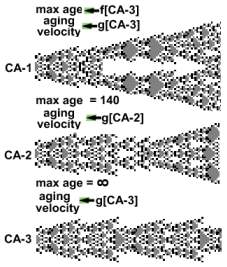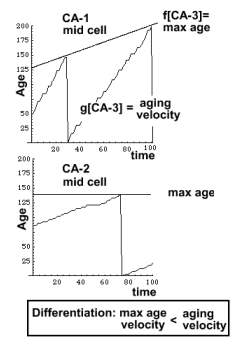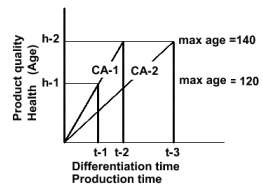 |
Process differentiation control
Differentiation is defined as change in structure which involves two processes: 1. Change of the cell itself, 2. Change of the spatial relationship between cells. The first is manifested by a change in aging velocity. The second is determined by age max. We start with three CA. CA-1 aging and differentiation are controlled by CA-3. CA-2 controls its aging while its differentiation is controlled by the observer who sets max age = 140. CA-3 does not differentiate (max age is infinite)
 |
 |
Process control
The experiment demonstrates the essence of process control.
CA-3 controls CA-1 differentiation by manipulating aging velocity and max
age. Aging acceleration and
max age deceleration, may independently accelerate differentiation velocity, yet their effect is not the same. Let's study two CA depicted below. CA-1 max age = 120 , and CA-2 max age
= 140. From t = 0 and on CA-1 ages faster than CA-2, and crosses its age max (=120)
earlier than CA-2 (age max = 140 ). CA-1 differentiates earlier than CA-2
Upon differentiation,
CA-2 cells are older than
CA-1. Since biological age is proportional
to health. CA-2 cells are healthier than CA-1 cells. In order to make CA-1 cells as healthy as those of CA-2
and let it differentiate earlier than CA-2 , aging
has to be generally accelerated and max age raised (to make the
example simple, aging velocity was kept constant) . The interplay of the two factors, determines
product quantity and quality.
 |
Both factors continually fluctuate (accelerate and decelerate),
like in CA-1. mid cell. If its velocity exceeds max age it will differentiate,
otherwise it will continue
accumulating age (health, or product) without differentiating.
Setup
zygote -> effect[1, 1000]; go[63]; zygote ->
effect[2, 1000]; go[109]; zygote -> effect[3, 1000]; go[109]; restoreparams; nca=3; toamplify =3.4; age[[no]] += a[[no]]; age[[1]] +=(toamplify
a[[3]]); effect[1, maxage
= age[[3, 50]] + 40]; effect[2.140]; effect[3, 1000]; go[100];